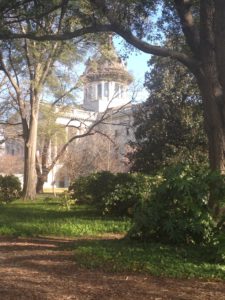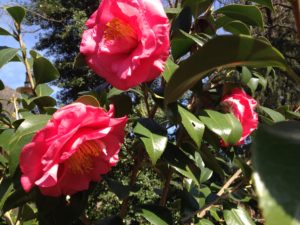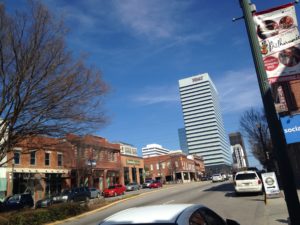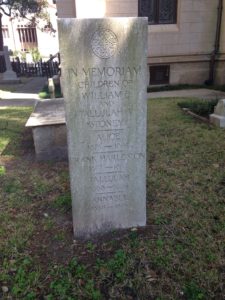Feb. 15: Our trip from Lake Marion to Savannah was somewhat exciting. After the tree was cleared from the road and we were able to proceed, we got onto I 95, a very major multi-lane north-south route. Despite the rain, traffic was moving well. Suddenly, our phones began to wail – tornado warning!
What do you do in tornado weather when you are going 60 mph on a major road in a large RV (which feels every gust of wind and passing truck) towing a car which has 2 sail-like kayaks on the roof? I was in favor of pulling over, even though there was no shelter. Chuck was in favor of carrying on. I anxiously scanned the skies for funnel clouds but it did not even look particularly cloudy. The weather app continued to insist that there was a warning, and in fact the phones howled again. (Since then, I have been told that stopping under an underpass is best, when feasible – I am not sure this would work on I 95.)
When we finally got to a truck stop, the skies were blue, the rain had stopped and wind was minimal. However, the person who was in charge of the propane told us that he could not open the pumps due to the storm conditions, and that he had watched the tornado front move parallel to I95 but about a mile to the west on a weather radar channel. There had been consider tornado damage in Georgia a couple of weeks earlier, but this time the storm did not touch down.
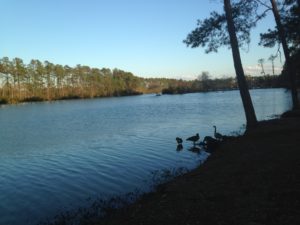 The remainder of the trip was uneventful. Our KOA campground has a small attractive lake with many domestic mute swans, lots of Canada geese and cormorants. The lake is lined with alligator warnings, but no alligators so far. The campground also has many, many dogs.
The remainder of the trip was uneventful. Our KOA campground has a small attractive lake with many domestic mute swans, lots of Canada geese and cormorants. The lake is lined with alligator warnings, but no alligators so far. The campground also has many, many dogs.
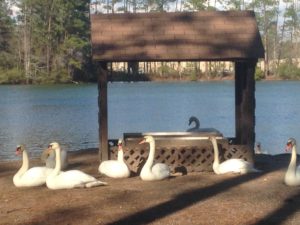 Our campsite is on the opposite edge of the campground from the lake, and overlooks a new growth woodland owned by a hunting club – no signs of hunting, however.
Our campsite is on the opposite edge of the campground from the lake, and overlooks a new growth woodland owned by a hunting club – no signs of hunting, however.
Chuck has been working mornings, so we are spending only the afternoons and evenings on sightseeing. That seems to work well for Savannah, however, as eight hours of being tourists is sufficient for us, and Savannah is hopping in the evening.
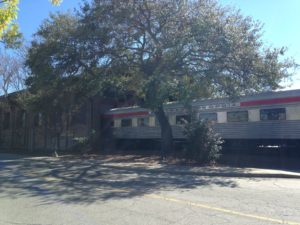 The Savannah tourist information bureau is in the old train station, along with the Savannah History Museum. It has a huge parking lot. Uniquely, it allows RV overnight parking. We did not take advantage of this, but it is a very convenient location in the heart of the historic city (no utilities, however). The train that appears to be entering the Visitor Center is used as office space.
The Savannah tourist information bureau is in the old train station, along with the Savannah History Museum. It has a huge parking lot. Uniquely, it allows RV overnight parking. We did not take advantage of this, but it is a very convenient location in the heart of the historic city (no utilities, however). The train that appears to be entering the Visitor Center is used as office space.
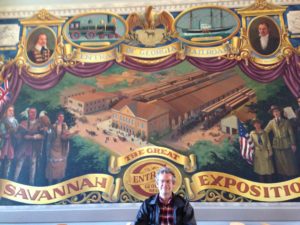
This beautiful mural with historic scenes is the first thing that greets visitors inside the Visitor Center.
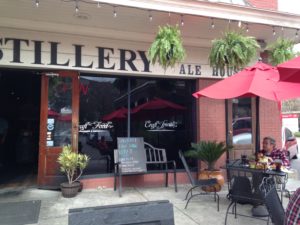
Just across the road from the Savannah Visitor Center is the Distillery, a brewhouse restaurant in a building that went from pub to drugstore (during Prohibition) and back to pub. It seems to have a great selection of beers. For us the attraction was that we could sit outside with Rumple. Not only were they fine with Rumple, on our first visit he was served 4 little dog biscuits on his own plate! We had lunch there every day we visited Savannah.
On our first visit, we went to the Historical Museum, which had a fine historical display, as well as information about industry in Savannah and of course the Revolutionary and Civil Wars. The Patriots suffered a devastating loss in Savannah, and it continued to be occupied by the British well after the surrender of Cornwallis at Yorktown. During the Civil War, Savannah surrendered to Sherman, thus escaping the destruction suffered by Sherman’s March to the Sea campaign.
An interesting exhibit at the History Museum documented the life of Juliet “Daisy” Gordon Low, the founder of the American Girl Scouts. A southern socialite, she married well and moved to England with her husband. When he turned out to be an unfaithful louse, she divorced him. In the meantime, she had developed a lot of practical skills, including both those typical for a woman of her status at the time, like painting, and atypical, such as artistic blacksmithing and nursing. When she met Sir Baden-Powell, founder of the Boy Scouts, she became enamored of the idea of working with the Girl Guides, the sister organization started by Baden-Powell’s sister. After organizing troupes in Scotland and England, she moved back to Savannah where she started the movement, and renamed it Girl Scouts. (In Canada, it is still Girl Guides.) She encouraged the girls to gain practical skills while having fun, and with her wide interests provided many opportunities. The headquarters of the Girl Scouts of America is still in Savannah.
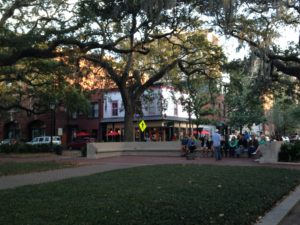 Historic Savannah is beautiful – there is no other word for it. There are mature live oaks, spreading massive branches over gardens bright with azaleas.
Historic Savannah is beautiful – there is no other word for it. There are mature live oaks, spreading massive branches over gardens bright with azaleas. 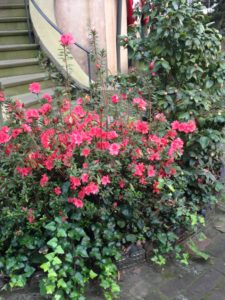
There are beautiful old state houses and lovely row houses. There are many old big churches and synagogues. And there are two restaurant/night life districts.
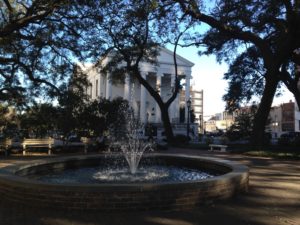
Savannah was constructed so that each neighborhood was built around a commons – now a square, with residential units on one side and “trust” lands on the other. Originally there were 4 squares laid out – then 6. Currently, there are 22 of these squares, mostly laid out in a grid so that the connecting streets are all interrupted by the squares, and the major roads run unobstructed between them. All of the squares have gardens and benches – many have historical monuments or fountains or other points of interest. Both the squares and the major streets are shaded by massive live oaks. Many of the squares also border beautiful old houses of worship and huge stately homes (some of which are now open as museums). It is all compact enough to handle on foot.
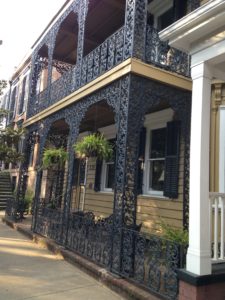
This house is likely not historic, but I liked the ironwork.
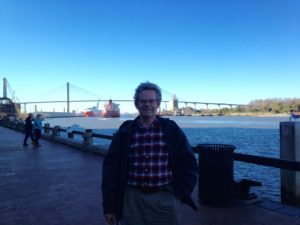
T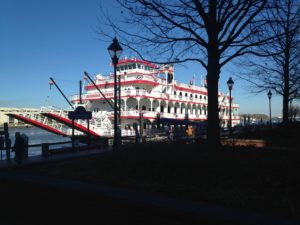 he city sits on a cliff over the Savannah River. The river bank is now a park, while the cliff face houses touristy shops and restaurants. At the street level above, a couple of blocks inland, is the City Market, which comes alive at night with outdoor restaurant seating and live music.
he city sits on a cliff over the Savannah River. The river bank is now a park, while the cliff face houses touristy shops and restaurants. At the street level above, a couple of blocks inland, is the City Market, which comes alive at night with outdoor restaurant seating and live music.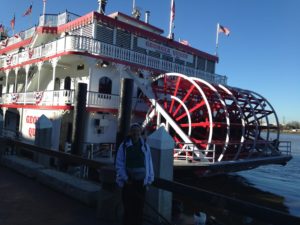
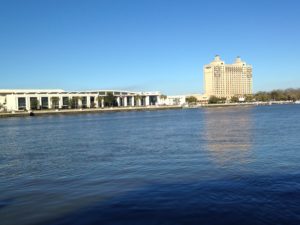
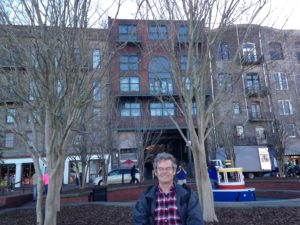
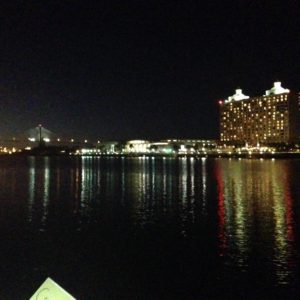
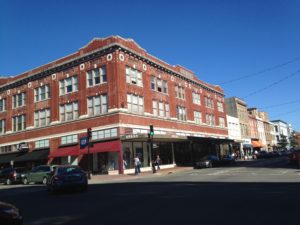
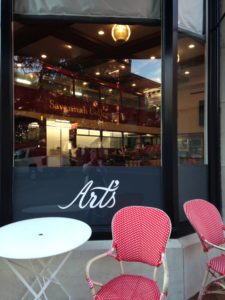 Another feature of the historic city is the Savannah College of Art and Design, which seems to occupy just about every large building, particularly the historic ones, including a former synagogue (below).
Another feature of the historic city is the Savannah College of Art and Design, which seems to occupy just about every large building, particularly the historic ones, including a former synagogue (below).
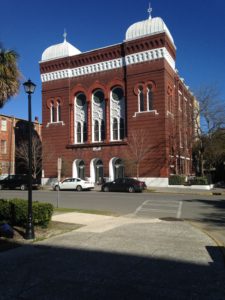 There are many, many shops selling beautiful artwork, presumably by SCAD students. And a cute SCAD coffee shop.
There are many, many shops selling beautiful artwork, presumably by SCAD students. And a cute SCAD coffee shop.
Once we were “museumed out” we walked around downtown, through the lovely squares and also along the river front. During our walk, we discovered an Irish pub that offered nightly music, so we went back there for dinner. The singer was very good, with a repertoire that was clearly Irish or Irish-Canadian, but covered mostly songs we had not heard before. He was also very entertaining between sets, and could have done fine as a stand-up comedian.
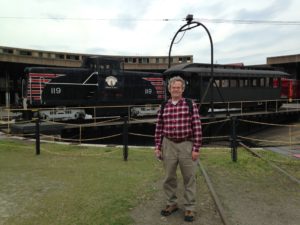 Day two in Savannah was somewhat of a repeat of day 1. We started at the Railway Museum, which turned out to be the repair shops that serviced the trains. We did two tours – one of the workshop for the freight cars, which included a tour of actual freight cars, and the other of the executive carriage cars which were used by the railway executives for their trips and to entertain clients.
Day two in Savannah was somewhat of a repeat of day 1. We started at the Railway Museum, which turned out to be the repair shops that serviced the trains. We did two tours – one of the workshop for the freight cars, which included a tour of actual freight cars, and the other of the executive carriage cars which were used by the railway executives for their trips and to entertain clients.
It w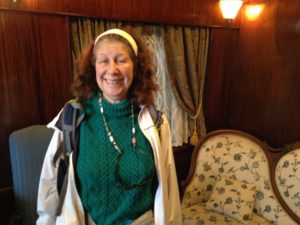 as striking that at least some of the design features of our RV date back to these luxury cars. Unfortunately, the RV does not come with valet and cook.
as striking that at least some of the design features of our RV date back to these luxury cars. Unfortunately, the RV does not come with valet and cook.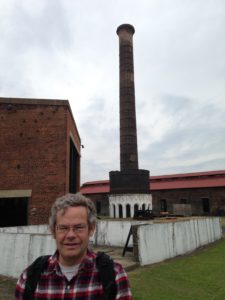
This is the chimney in the train repair yard.
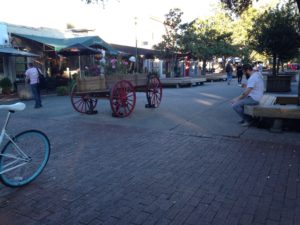 The remainder of the day we just enjoyed the ambience. We had dinner outside at the City Market and enjoyed the music. We enjoyed peach sangria as the evening fell.
The remainder of the day we just enjoyed the ambience. We had dinner outside at the City Market and enjoyed the music. We enjoyed peach sangria as the evening fell.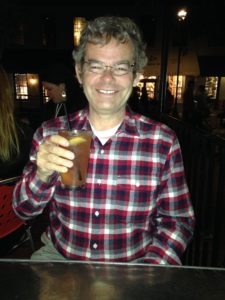
On our final day in Savannah, we decided to just walk around, finishing with dinner at the Irish pub. Savannah was having an Irish festival, and the singer at the Irish pub had noted that it was likely that many performers would be coming back in the evening for a pint and an informal session.
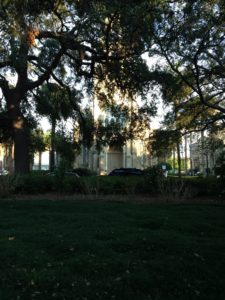 We decided to split up for our walking tour, as Chuck wanted to go to a book fair, and I wanted to see the synagogue. My walk took me past several of the large churches as well. Since it was the weekend, the synagogue and all the churches were closed to tourism, but it was still interesting to see the buildings. If I had not deliberately set out to see the synagogue, I would have assumed it was also a church, as it had no artistic or architectural details that indicated otherwise. It can just be seen through the trees in this photo.
We decided to split up for our walking tour, as Chuck wanted to go to a book fair, and I wanted to see the synagogue. My walk took me past several of the large churches as well. Since it was the weekend, the synagogue and all the churches were closed to tourism, but it was still interesting to see the buildings. If I had not deliberately set out to see the synagogue, I would have assumed it was also a church, as it had no artistic or architectural details that indicated otherwise. It can just be seen through the trees in this photo.
We deliberated on the optimal time to put Rumple in the car and head to the pub so that we would be eating our meal late enough to keep our table for the show. Unfortunately (or perhaps fortunately) we miscalculated – no tables were available. We meandered around the tourist district and found that on Saturday evening in Savannah, waits of over an hour are the norm.
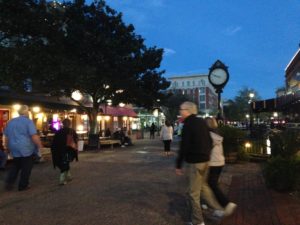 Finally, we ended back at the restaurant of the previous evening at the City Market, with the same singer providing background music. However very soon, it was not background music at all – he started playing dance tunes, and the crowd was very willing to join in. After dinner we joined the fun – it was like being at a very big outdoor wedding, with everything except the chicken dance! We had a blast!
Finally, we ended back at the restaurant of the previous evening at the City Market, with the same singer providing background music. However very soon, it was not background music at all – he started playing dance tunes, and the crowd was very willing to join in. After dinner we joined the fun – it was like being at a very big outdoor wedding, with everything except the chicken dance! We had a blast!
We love Savannah!
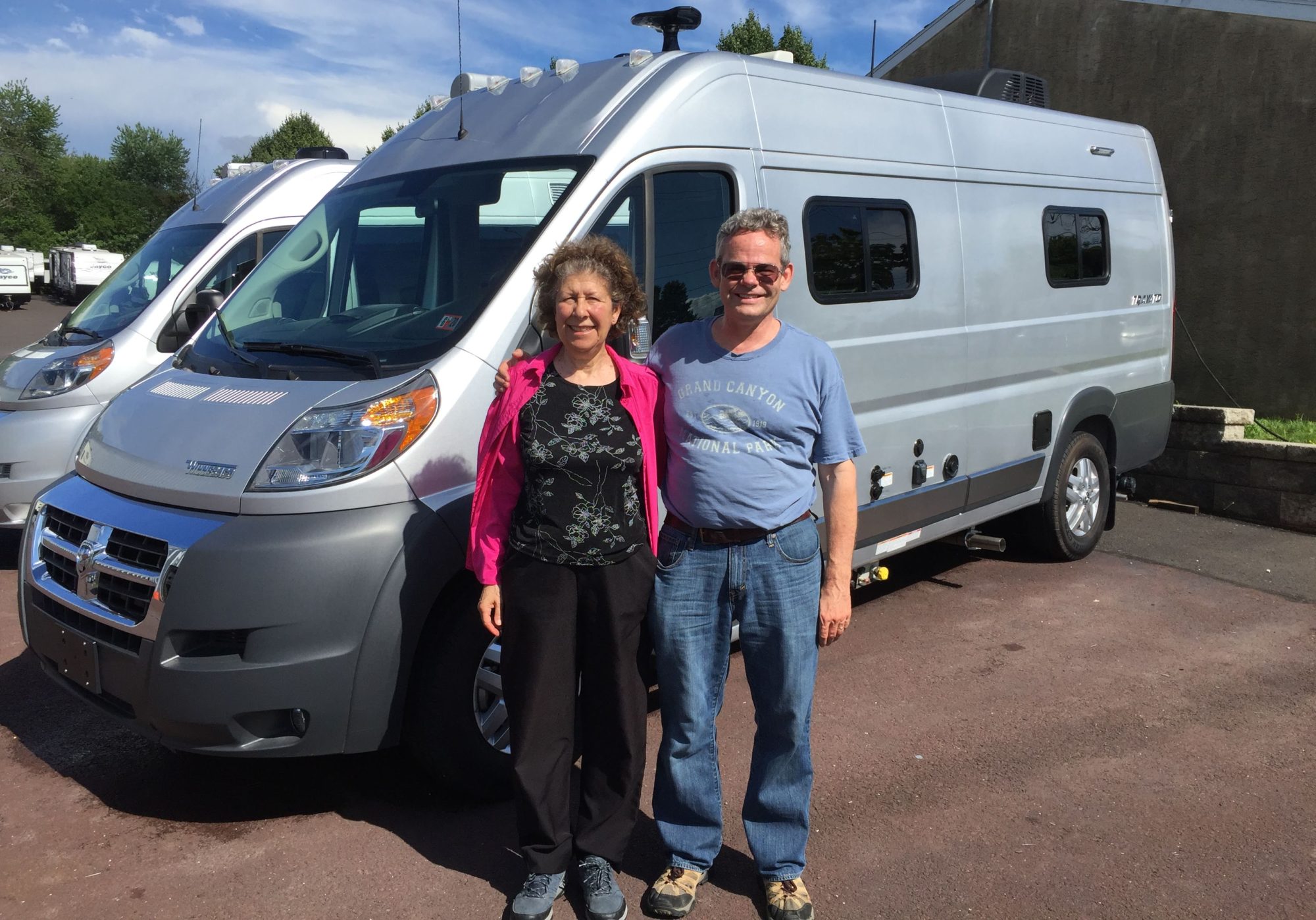
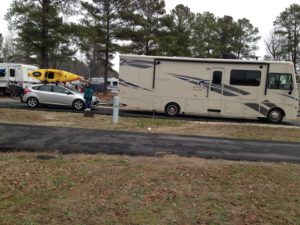 Our RV is a “Class A” which essentially looks like a bus. Ours is build on a truck chassis. RVs made from bus chasses are super-expensive. We recently camped beside a real bus RV. Chuck looked up the list price – about 2.5 million dollars new!
Our RV is a “Class A” which essentially looks like a bus. Ours is build on a truck chassis. RVs made from bus chasses are super-expensive. We recently camped beside a real bus RV. Chuck looked up the list price – about 2.5 million dollars new!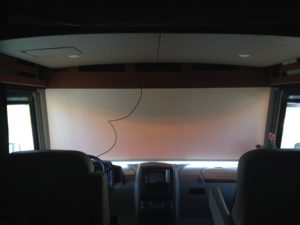 The cab has the driver and passenger seats, a huge front windshield that serves as our “picture window” when parked, and two large side windows. In this photo, the sunscreen is down – without this it is so bright I could not take the photo.
The cab has the driver and passenger seats, a huge front windshield that serves as our “picture window” when parked, and two large side windows. In this photo, the sunscreen is down – without this it is so bright I could not take the photo.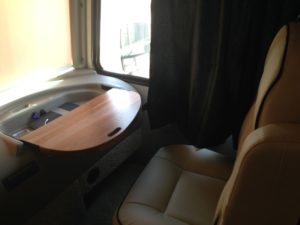 We tend to keep light-weight objects there, just in case a sudden stop sends thing flying. Above the cab is a drop-down double bed. The white “ceiling” in the photo is the bottom of the bed. This is our preferred sleeping area for guests, as the bed can be lifted already made up during the day.
We tend to keep light-weight objects there, just in case a sudden stop sends thing flying. Above the cab is a drop-down double bed. The white “ceiling” in the photo is the bottom of the bed. This is our preferred sleeping area for guests, as the bed can be lifted already made up during the day.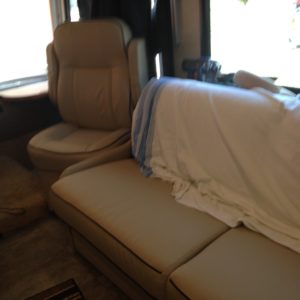 Behind the cab is the living/dining room. On one side we have a sofa which flips down to become a double bed. Both seats in the cab swing around and become lounge chairs which are part of our living room. The blanket thrown over the back of the sofa keeps small objects from dropping from the window ledge into the space behind the sofa – which has plenty of storage space but is very hard to access.
Behind the cab is the living/dining room. On one side we have a sofa which flips down to become a double bed. Both seats in the cab swing around and become lounge chairs which are part of our living room. The blanket thrown over the back of the sofa keeps small objects from dropping from the window ledge into the space behind the sofa – which has plenty of storage space but is very hard to access.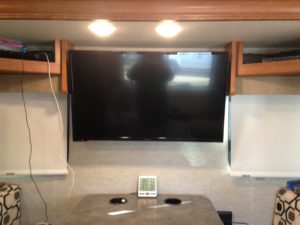
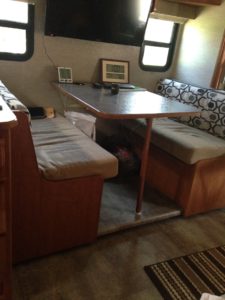
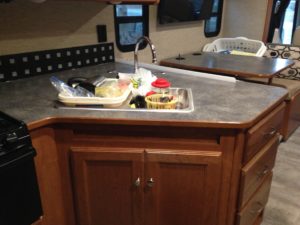 The table can also be see behind the kitchen in this photo.
The table can also be see behind the kitchen in this photo.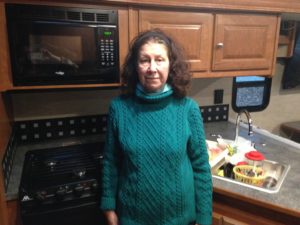
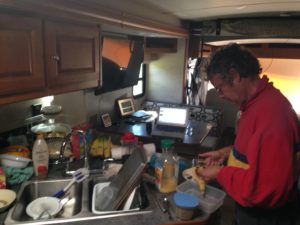 We also have a built in microwave and a fridge which can work on electricity or propane. Here is what the kitchen looks like when it is actually in use. It is very cluttered – in part because most of the counter space is behind the sink and so can be used only for storage (while stationary).
We also have a built in microwave and a fridge which can work on electricity or propane. Here is what the kitchen looks like when it is actually in use. It is very cluttered – in part because most of the counter space is behind the sink and so can be used only for storage (while stationary).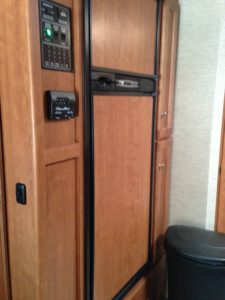 The fridge is quite shallow, so it is even smaller than it looks. The freezer compartment is full depth however. Along with the built-in appliances we brought a toaster oven, slow cooker, electric hot pot and electric kettle. We pretty much cook the same way we do at home, except that we cannot roast a whole chicken. (We find those roasted chickens from the supermarket to be very convenient.)
The fridge is quite shallow, so it is even smaller than it looks. The freezer compartment is full depth however. Along with the built-in appliances we brought a toaster oven, slow cooker, electric hot pot and electric kettle. We pretty much cook the same way we do at home, except that we cannot roast a whole chicken. (We find those roasted chickens from the supermarket to be very convenient.)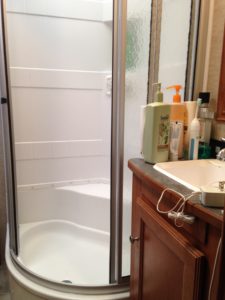
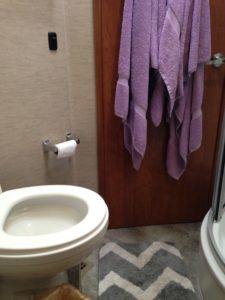 Behind the kitchen we have the bathroom with a full-size shower, sink and toilet. It has a very good fan for ventilation in the roof. Hot water is heated in a very efficient propane water heater.
Behind the kitchen we have the bathroom with a full-size shower, sink and toilet. It has a very good fan for ventilation in the roof. Hot water is heated in a very efficient propane water heater.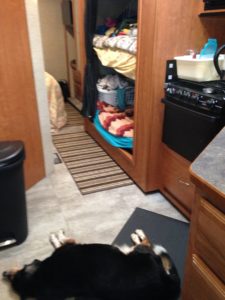 Across the corridor from the bathroom are the bunk beds. The top bunk is usually piled high with Naomi’s junk – primarily knitting and reading material. It folds up to allow a clothing bar to fold down – turning the area into a full-sized wardrobe. The lower bunk is Rumple’s space and the home of our laundry basket. As you see here, Rumple is no longer excited about having his own bed, and usually grabs a nap on one of our many floor mats.
Across the corridor from the bathroom are the bunk beds. The top bunk is usually piled high with Naomi’s junk – primarily knitting and reading material. It folds up to allow a clothing bar to fold down – turning the area into a full-sized wardrobe. The lower bunk is Rumple’s space and the home of our laundry basket. As you see here, Rumple is no longer excited about having his own bed, and usually grabs a nap on one of our many floor mats.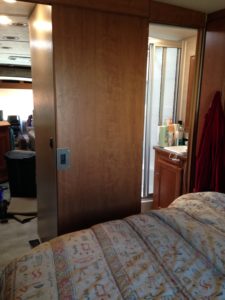 The final section of the RV is the bedroom, with a queen-sized bed, wardrobe, dresser, TV, additional shelving, slide-out desk and another big fan (which is very efficient and also quiet). The bedroom has direct access to the bathroom, but can be isolated from the rest of the RV.
The final section of the RV is the bedroom, with a queen-sized bed, wardrobe, dresser, TV, additional shelving, slide-out desk and another big fan (which is very efficient and also quiet). The bedroom has direct access to the bathroom, but can be isolated from the rest of the RV.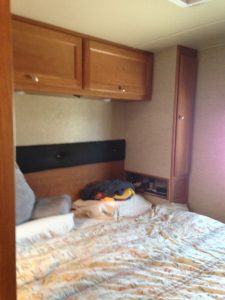

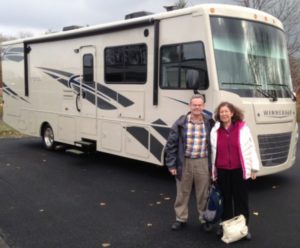 Outside the RV we have multiple storage compartments, propane tank, electrical generator, and our electrical, water and sewer connections. If you look closely, you can see two of the storage compartments behind Chuck at waist level. We also have a large electric awning (with LED lights) which is the black frame in the picture. There is also an exterior TV below the large side window, which we guess is for tailgating. Most campsites offer a picnic table and fire ring or grill.
Outside the RV we have multiple storage compartments, propane tank, electrical generator, and our electrical, water and sewer connections. If you look closely, you can see two of the storage compartments behind Chuck at waist level. We also have a large electric awning (with LED lights) which is the black frame in the picture. There is also an exterior TV below the large side window, which we guess is for tailgating. Most campsites offer a picnic table and fire ring or grill.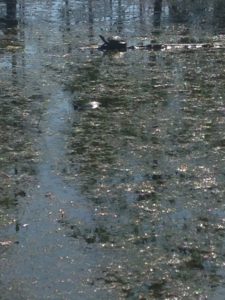 Our trip was not a complete waste, however. The Visitor Center sits on a branch of the Suwanee canal that is quite popular with big turtles and big gators. We saw many, many dinner-plate sized turtles and 2 very big alligators. According to Wikipedia, alligators eat the turtles, which may explain why the gators like to hang around the Visitor Center but does not explain why the turtles do.
Our trip was not a complete waste, however. The Visitor Center sits on a branch of the Suwanee canal that is quite popular with big turtles and big gators. We saw many, many dinner-plate sized turtles and 2 very big alligators. According to Wikipedia, alligators eat the turtles, which may explain why the gators like to hang around the Visitor Center but does not explain why the turtles do.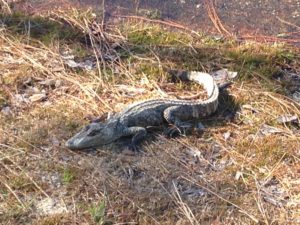 We also took a scenic drive that included a stop at a small pond, inhabited by at least 5 baby gators and their mama. This photo is a close-up of a baby that was about 18 inches long and much more colorful and lizard-like than the large alligators.
We also took a scenic drive that included a stop at a small pond, inhabited by at least 5 baby gators and their mama. This photo is a close-up of a baby that was about 18 inches long and much more colorful and lizard-like than the large alligators. 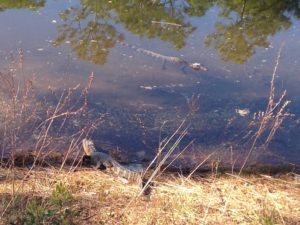 (The large ones look like logs in the water and like bronze sculptures when sunning) A young man impressing a girl friend splashed at the side of the pond, which send the babies into the water in a rush to be with mom. Fortunately, no “accidents” occurred. (My sympathies would have been with mama gator.)
(The large ones look like logs in the water and like bronze sculptures when sunning) A young man impressing a girl friend splashed at the side of the pond, which send the babies into the water in a rush to be with mom. Fortunately, no “accidents” occurred. (My sympathies would have been with mama gator.)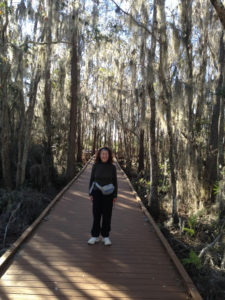
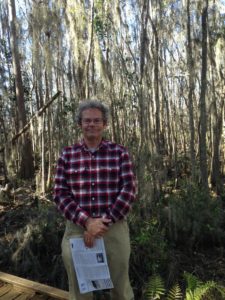
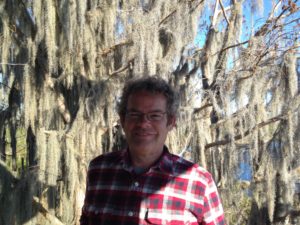
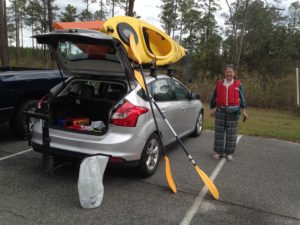 On Monday, our friends Ron and Judy volunteered to watch Rumple while we kayaked in the swamp. We headed for a closer entrance to the Suwanee, King Fisher Landing, where another friend, David, had told us he had seen many alligators. It was a very pleasant paddle, and had the advantage that, unlike the main park entrance, kayaks were allowed on the water until sundown.
On Monday, our friends Ron and Judy volunteered to watch Rumple while we kayaked in the swamp. We headed for a closer entrance to the Suwanee, King Fisher Landing, where another friend, David, had told us he had seen many alligators. It was a very pleasant paddle, and had the advantage that, unlike the main park entrance, kayaks were allowed on the water until sundown. 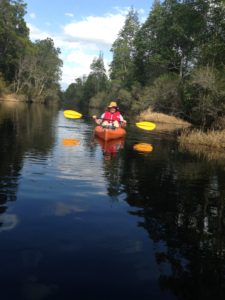 This area also had a lot of alligators and turtles.
This area also had a lot of alligators and turtles.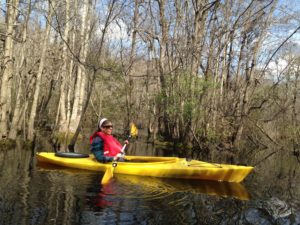
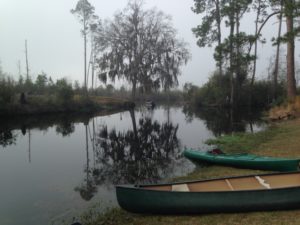 On Tuesday we returned to the Visitor Center fairly early in the morning for a very satisfying experience. While it was still cool we left Rumple in the car and kayaked the canal. We saw lots and lots of alligators – mostly waiting in the water for prey, but also a few that swam along-side the kayaks or sunned on the banks.
On Tuesday we returned to the Visitor Center fairly early in the morning for a very satisfying experience. While it was still cool we left Rumple in the car and kayaked the canal. We saw lots and lots of alligators – mostly waiting in the water for prey, but also a few that swam along-side the kayaks or sunned on the banks.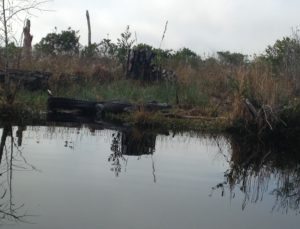
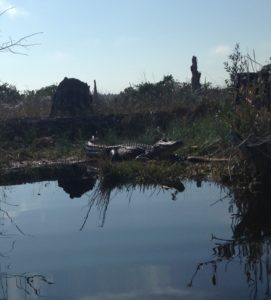
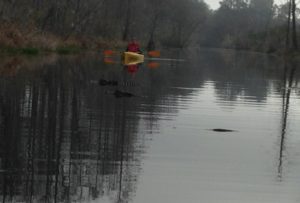
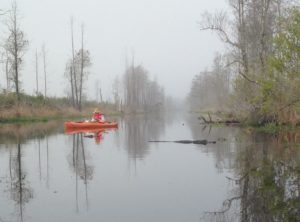 There are also a lot of large birds including herons, cormorants and ospreys, while the call of the Sandhill cranes (which sound like very large frogs) can be heard throughout.
There are also a lot of large birds including herons, cormorants and ospreys, while the call of the Sandhill cranes (which sound like very large frogs) can be heard throughout. 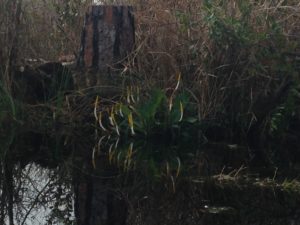
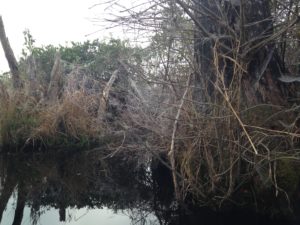
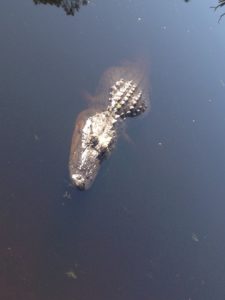 When it got too hot to leave Rumple in the car, we returned to the Visitor Center to find that the canal just outside the center was filled with big gators.
When it got too hot to leave Rumple in the car, we returned to the Visitor Center to find that the canal just outside the center was filled with big gators.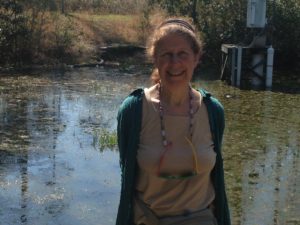
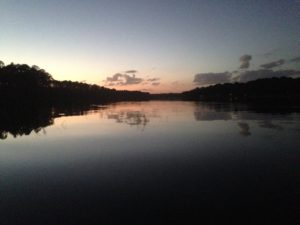 Feb. 23: Okefenokee Swamp, home of the Pogo comic strip, is a national park in Georgia. We decided to camp in the Laura S. Walker State Park, which has a small lake. Actually, it was a bit of a mix-up: the Okefenokee Swamp Park, which is a private non-profit, is close to the State Park, while the Okefenokee National Wildlife Refuge is quite a bit further down the road. However, we have really enjoyed our time here.
Feb. 23: Okefenokee Swamp, home of the Pogo comic strip, is a national park in Georgia. We decided to camp in the Laura S. Walker State Park, which has a small lake. Actually, it was a bit of a mix-up: the Okefenokee Swamp Park, which is a private non-profit, is close to the State Park, while the Okefenokee National Wildlife Refuge is quite a bit further down the road. However, we have really enjoyed our time here.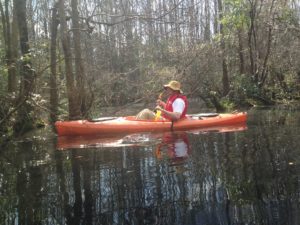 With alligator warning signs on all the lakes, we are a bit leery of taking Rumple in the kayak. A circuit of Laura Walker Lake takes about an hour, so we are kayaking in the late afternoon, when the temperatures are cooler (and Rumple is ready for a nap).
With alligator warning signs on all the lakes, we are a bit leery of taking Rumple in the kayak. A circuit of Laura Walker Lake takes about an hour, so we are kayaking in the late afternoon, when the temperatures are cooler (and Rumple is ready for a nap).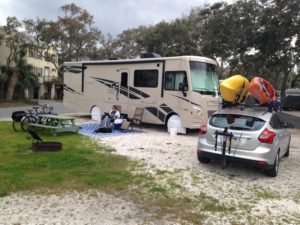 Feb. 20: We headed northeast of Savannah for the beach resort and historic town of Tybee Island in the Savannah River estuary. Although Tybee is slightly to the north of Savannah, it seems to have a milder climate, based on the vegetation. As I type I am looking at bottlebrush and rose bushes in full bloom. In Savannah, it was spring, with the azaleas just starting to bloom and a lot of pansies in pots. In Tybee everything seems to be blooming at once: azaleas, roses and camelias, lantana, hibiscus and snapdragons. There are citrus trees full of fruit, palms and their relatives and the ubiquitous live oaks and loblolly pines.
Feb. 20: We headed northeast of Savannah for the beach resort and historic town of Tybee Island in the Savannah River estuary. Although Tybee is slightly to the north of Savannah, it seems to have a milder climate, based on the vegetation. As I type I am looking at bottlebrush and rose bushes in full bloom. In Savannah, it was spring, with the azaleas just starting to bloom and a lot of pansies in pots. In Tybee everything seems to be blooming at once: azaleas, roses and camelias, lantana, hibiscus and snapdragons. There are citrus trees full of fruit, palms and their relatives and the ubiquitous live oaks and loblolly pines.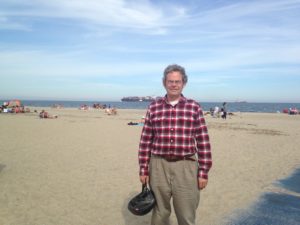
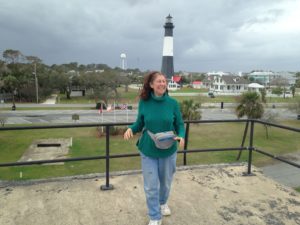 During the Civil War, it was burned by the retreating Confederates, who were worried that it would be an asset to the Union troops. Fortunately (for the Union and for future generations) the concrete building withstood the fire – only the wooden interior stairs were destroyed and they were quickly rebuilt by the Union forces. The old base was used to build the more modern structure that remains and is now a museum, along with several of the buildings that housed the lighthouse keeper and his family around 1919. Although the lighthouse itself was closed for repairs to the stairs, the outbuildings were quite interesting, containing many of the furnishings from the family that lived there in the 1930s.
During the Civil War, it was burned by the retreating Confederates, who were worried that it would be an asset to the Union troops. Fortunately (for the Union and for future generations) the concrete building withstood the fire – only the wooden interior stairs were destroyed and they were quickly rebuilt by the Union forces. The old base was used to build the more modern structure that remains and is now a museum, along with several of the buildings that housed the lighthouse keeper and his family around 1919. Although the lighthouse itself was closed for repairs to the stairs, the outbuildings were quite interesting, containing many of the furnishings from the family that lived there in the 1930s.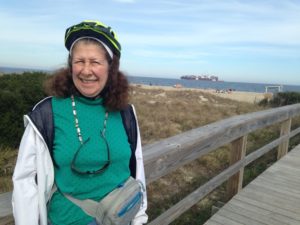 The dunes are nesting places for shore birds and sea turtles and are therefore protected habitat. Long board walks stretch from the roads to over the dunes to the beaches. At the Marine Science Center we learned from the docent that the beach itself is now too wide for the sea turtles. After the mothers have completed their laying, the nests are routinely moved by staff to more sheltered locations in the dunes if necessary.
The dunes are nesting places for shore birds and sea turtles and are therefore protected habitat. Long board walks stretch from the roads to over the dunes to the beaches. At the Marine Science Center we learned from the docent that the beach itself is now too wide for the sea turtles. After the mothers have completed their laying, the nests are routinely moved by staff to more sheltered locations in the dunes if necessary. 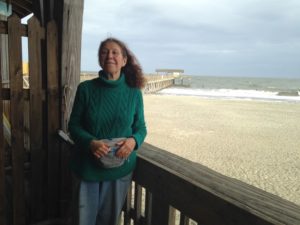 The nests are carefully watched by volunteers until hatching. Finally, after the hatchlings have left the nest, stragglers may be transported for rearing in the Center. If an egg-bearing female has been killed while searching for a nesting site (e.g. if she was struck by a car) her eggs will be taken to the Armstrong Atlantic State University for incubation. The Center had a number of baby diamondback turtles and a 2 year old loggerhead when we visited. All are due to be released to the wild quite soon.
The nests are carefully watched by volunteers until hatching. Finally, after the hatchlings have left the nest, stragglers may be transported for rearing in the Center. If an egg-bearing female has been killed while searching for a nesting site (e.g. if she was struck by a car) her eggs will be taken to the Armstrong Atlantic State University for incubation. The Center had a number of baby diamondback turtles and a 2 year old loggerhead when we visited. All are due to be released to the wild quite soon.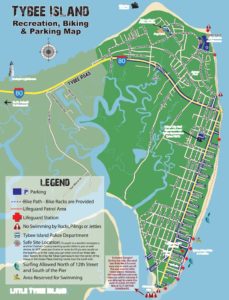 Tybee Island is perfect for biking, as most of the roads are quiet and the entire town is less than 3 miles long. We used our bicycles as the vehicles of choice while sightseeing. We biked all the bicycle paths.
Tybee Island is perfect for biking, as most of the roads are quiet and the entire town is less than 3 miles long. We used our bicycles as the vehicles of choice while sightseeing. We biked all the bicycle paths.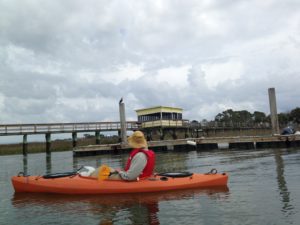 The salt marsh is fed by many meandering creeks, which have a basic flow towards the sea, but which are usually reversed at high tide. Most of these are now lined by homes with docks, which means that the creek beds have been stabilized. I could not help but wonder what the long-term environmental effects of this will be. The current configuration did survive Hurricane Matthew this past October.
The salt marsh is fed by many meandering creeks, which have a basic flow towards the sea, but which are usually reversed at high tide. Most of these are now lined by homes with docks, which means that the creek beds have been stabilized. I could not help but wonder what the long-term environmental effects of this will be. The current configuration did survive Hurricane Matthew this past October.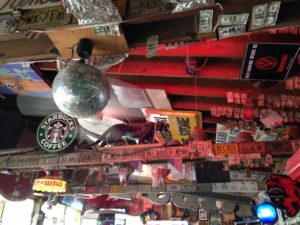 Although the town is full of cottage rentals, it lacks another beach town feature. There are only a few touristy shops as you enter the town, and hardly any downtown. There are a lot of eccentric restaurants/pubs, however. At the advice of a long-time visitor, we went to Huc-A-Poos, which takes this to the extreme. The outside veranda is decorated with a mish-mash of interesting stuff. The interior has a ceiling lined with vinyl album covers, at least one wall of old license plates, a bar lined with signed one dollar bills, old stuffed animals tacked to the beams, an old gas pump, etc.
Although the town is full of cottage rentals, it lacks another beach town feature. There are only a few touristy shops as you enter the town, and hardly any downtown. There are a lot of eccentric restaurants/pubs, however. At the advice of a long-time visitor, we went to Huc-A-Poos, which takes this to the extreme. The outside veranda is decorated with a mish-mash of interesting stuff. The interior has a ceiling lined with vinyl album covers, at least one wall of old license plates, a bar lined with signed one dollar bills, old stuffed animals tacked to the beams, an old gas pump, etc. 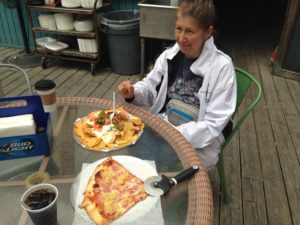 The shot above is part of the wall and ceiling – note the dollar bills, license plates and general junk. Huc-A-Poos also has very good food. In fact, the nachos (pictured) are second in my experience only to Happy Valley Brewery. We highly recommend it.
The shot above is part of the wall and ceiling – note the dollar bills, license plates and general junk. Huc-A-Poos also has very good food. In fact, the nachos (pictured) are second in my experience only to Happy Valley Brewery. We highly recommend it.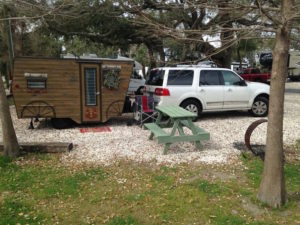 One interesting thing we noted at the RV park was an abundance of very small RVs, some elaborately decorated. I chatted with owner of Nana’s B&B (below) who told me that there was a group of about 30 women who meet several times per year – no husbands, offspring or pets allowed – at various RV parks.
One interesting thing we noted at the RV park was an abundance of very small RVs, some elaborately decorated. I chatted with owner of Nana’s B&B (below) who told me that there was a group of about 30 women who meet several times per year – no husbands, offspring or pets allowed – at various RV parks. 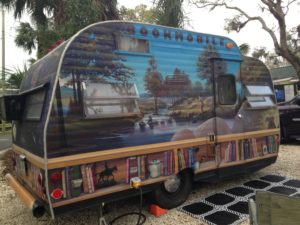 They host RV interior tours to raise money for charity. Since we were leaving before the tour, she invited me in for a peek at her own very elaborately decorated mini-RV. It had all the amenities in a tiny space, and every inch was covered in needlework, arts and crafts.
They host RV interior tours to raise money for charity. Since we were leaving before the tour, she invited me in for a peek at her own very elaborately decorated mini-RV. It had all the amenities in a tiny space, and every inch was covered in needlework, arts and crafts. 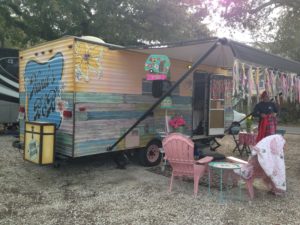 While the “Bookmobile” was painted by a professional muralist, Nana’s was the work of the owner and resembled a weather-beaten shingle house – all hand-painted including the wood grain.
While the “Bookmobile” was painted by a professional muralist, Nana’s was the work of the owner and resembled a weather-beaten shingle house – all hand-painted including the wood grain. The remainder of the trip was uneventful. Our KOA campground has a small attractive lake with many domestic mute swans, lots of Canada geese and cormorants. The lake is lined with alligator warnings, but no alligators so far. The campground also has many, many dogs.
The remainder of the trip was uneventful. Our KOA campground has a small attractive lake with many domestic mute swans, lots of Canada geese and cormorants. The lake is lined with alligator warnings, but no alligators so far. The campground also has many, many dogs. Our campsite is on the opposite edge of the campground from the lake, and overlooks a new growth woodland owned by a hunting club – no signs of hunting, however.
Our campsite is on the opposite edge of the campground from the lake, and overlooks a new growth woodland owned by a hunting club – no signs of hunting, however. The Savannah tourist information bureau is in the old train station, along with the Savannah History Museum. It has a huge parking lot. Uniquely, it allows RV overnight parking. We did not take advantage of this, but it is a very convenient location in the heart of the historic city (no utilities, however). The train that appears to be entering the Visitor Center is used as office space.
The Savannah tourist information bureau is in the old train station, along with the Savannah History Museum. It has a huge parking lot. Uniquely, it allows RV overnight parking. We did not take advantage of this, but it is a very convenient location in the heart of the historic city (no utilities, however). The train that appears to be entering the Visitor Center is used as office space.

 Historic Savannah is beautiful – there is no other word for it. There are mature live oaks, spreading massive branches over gardens bright with azaleas.
Historic Savannah is beautiful – there is no other word for it. There are mature live oaks, spreading massive branches over gardens bright with azaleas. 



 he city sits on a cliff over the Savannah River. The river bank is now a park, while the cliff face houses touristy shops and restaurants. At the street level above, a couple of blocks inland, is the City Market, which comes alive at night with outdoor restaurant seating and live music.
he city sits on a cliff over the Savannah River. The river bank is now a park, while the cliff face houses touristy shops and restaurants. At the street level above, a couple of blocks inland, is the City Market, which comes alive at night with outdoor restaurant seating and live music.




 Another feature of the historic city is the Savannah College of Art and Design, which seems to occupy just about every large building, particularly the historic ones, including a former synagogue (below).
Another feature of the historic city is the Savannah College of Art and Design, which seems to occupy just about every large building, particularly the historic ones, including a former synagogue (below). There are many, many shops selling beautiful artwork, presumably by SCAD students. And a cute SCAD coffee shop.
There are many, many shops selling beautiful artwork, presumably by SCAD students. And a cute SCAD coffee shop. Day two in Savannah was somewhat of a repeat of day 1. We started at the Railway Museum, which turned out to be the repair shops that serviced the trains. We did two tours – one of the workshop for the freight cars, which included a tour of actual freight cars, and the other of the executive carriage cars which were used by the railway executives for their trips and to entertain clients.
Day two in Savannah was somewhat of a repeat of day 1. We started at the Railway Museum, which turned out to be the repair shops that serviced the trains. We did two tours – one of the workshop for the freight cars, which included a tour of actual freight cars, and the other of the executive carriage cars which were used by the railway executives for their trips and to entertain clients. as striking that at least some of the design features of our RV date back to these luxury cars. Unfortunately, the RV does not come with valet and cook.
as striking that at least some of the design features of our RV date back to these luxury cars. Unfortunately, the RV does not come with valet and cook.
 The remainder of the day we just enjoyed the ambience. We had dinner outside at the City Market and enjoyed the music. We enjoyed peach sangria as the evening fell.
The remainder of the day we just enjoyed the ambience. We had dinner outside at the City Market and enjoyed the music. We enjoyed peach sangria as the evening fell.
 We decided to split up for our walking tour, as Chuck wanted to go to a book fair, and I wanted to see the synagogue. My walk took me past several of the large churches as well. Since it was the weekend, the synagogue and all the churches were closed to tourism, but it was still interesting to see the buildings. If I had not deliberately set out to see the synagogue, I would have assumed it was also a church, as it had no artistic or architectural details that indicated otherwise. It can just be seen through the trees in this photo.
We decided to split up for our walking tour, as Chuck wanted to go to a book fair, and I wanted to see the synagogue. My walk took me past several of the large churches as well. Since it was the weekend, the synagogue and all the churches were closed to tourism, but it was still interesting to see the buildings. If I had not deliberately set out to see the synagogue, I would have assumed it was also a church, as it had no artistic or architectural details that indicated otherwise. It can just be seen through the trees in this photo. Finally, we ended back at the restaurant of the previous evening at the City Market, with the same singer providing background music. However very soon, it was not background music at all – he started playing dance tunes, and the crowd was very willing to join in. After dinner we joined the fun – it was like being at a very big outdoor wedding, with everything except the chicken dance! We had a blast!
Finally, we ended back at the restaurant of the previous evening at the City Market, with the same singer providing background music. However very soon, it was not background music at all – he started playing dance tunes, and the crowd was very willing to join in. After dinner we joined the fun – it was like being at a very big outdoor wedding, with everything except the chicken dance! We had a blast!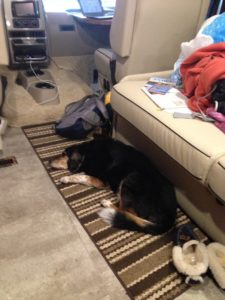 However, Rumple has not had any problems at all with the RV. He no longer uses his bed much, preferring to be closer to his humans. But he is relaxed, and gets out to have a stretch when we do.
However, Rumple has not had any problems at all with the RV. He no longer uses his bed much, preferring to be closer to his humans. But he is relaxed, and gets out to have a stretch when we do.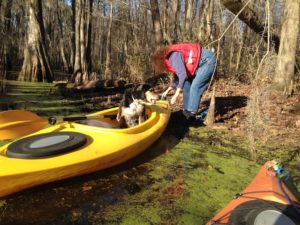 To get Rumple into the kayak, we lift him in from shore and then push the kayak into the water. Since he is pretty much sitting in Naomi’s lap, he tolerates this for about an hour before getting antsy and looking for a means to get to land. The other day he mistook a floating patch of duckweed for land and took a flying leap into the water.
To get Rumple into the kayak, we lift him in from shore and then push the kayak into the water. Since he is pretty much sitting in Naomi’s lap, he tolerates this for about an hour before getting antsy and looking for a means to get to land. The other day he mistook a floating patch of duckweed for land and took a flying leap into the water. 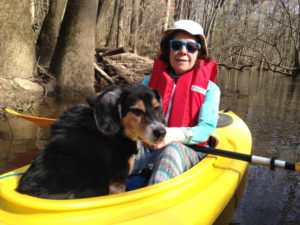 Our kayaks being pretty much rafts, the boat hardly rocked. However, Rumple got the shock of his life as he discovered that he was unable to touch bottom. Fortunately, this elderly dog with no swimming experience still had an instinct to dog paddle.
Our kayaks being pretty much rafts, the boat hardly rocked. However, Rumple got the shock of his life as he discovered that he was unable to touch bottom. Fortunately, this elderly dog with no swimming experience still had an instinct to dog paddle.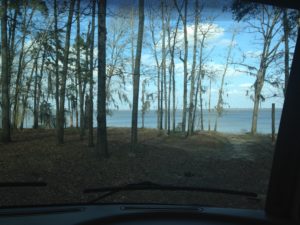 Feb. 13: After leaving Columbia, we decided to spend a few days doing more “wilderness” activities and headed for Santee State Park on Lake Marion, SC. Like many of the lakes in SC, this is a man-made lake, with a highly crenellated shore. It is really quite lovely, as you can see from the view from our window. It was also lovely at sunrise (and no thanks to Rumple for getting me out of bed that early).
Feb. 13: After leaving Columbia, we decided to spend a few days doing more “wilderness” activities and headed for Santee State Park on Lake Marion, SC. Like many of the lakes in SC, this is a man-made lake, with a highly crenellated shore. It is really quite lovely, as you can see from the view from our window. It was also lovely at sunrise (and no thanks to Rumple for getting me out of bed that early).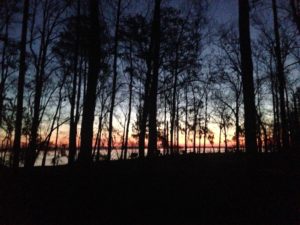
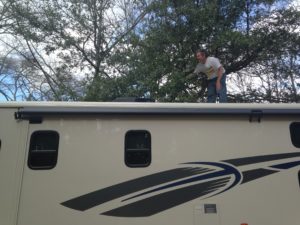 The RV is 12 ft high. It also has a number of items on the roof, including the TV antenna, air conditioner and fan vent openings. It can be a bit difficult to remember this when driving. Smaller roads have trees closer to the edge, as well as low-hanging branches.
The RV is 12 ft high. It also has a number of items on the roof, including the TV antenna, air conditioner and fan vent openings. It can be a bit difficult to remember this when driving. Smaller roads have trees closer to the edge, as well as low-hanging branches.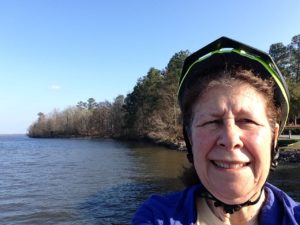
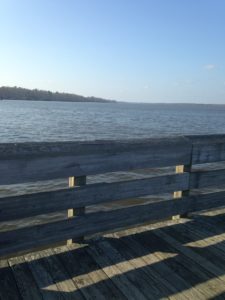
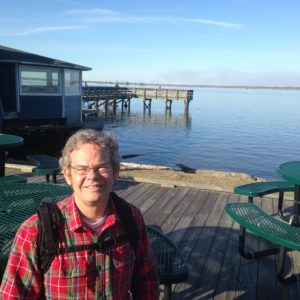 The next day was sunny but extremely windy. Kayaking was out of the question and even biking seemed iffy. We decided to walk along the lakeshore to the other campground. We soon found the other end of the bike path, and followed it instead. The photo shows Chuck at the other campground which features a fishing dock, store and wifi lounge (the latter 2 being closed during the week in the winter. We came back via the road. The entire hike took 4 hours. We are all in much better shape than we were when we started the trip, but we were still pretty tired by the time we got back to the RV.
The next day was sunny but extremely windy. Kayaking was out of the question and even biking seemed iffy. We decided to walk along the lakeshore to the other campground. We soon found the other end of the bike path, and followed it instead. The photo shows Chuck at the other campground which features a fishing dock, store and wifi lounge (the latter 2 being closed during the week in the winter. We came back via the road. The entire hike took 4 hours. We are all in much better shape than we were when we started the trip, but we were still pretty tired by the time we got back to the RV.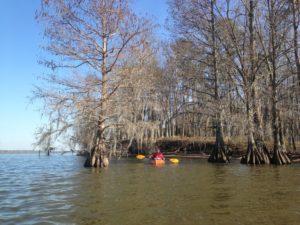 Tuesday was sunny and calm, so we were finally able to kayak. Although the original plan had been to camp in a spot where we could launch from the campsite, the trip to the other campground revealed two attractive features: a large sheltered bay and proximity to the “sunken forest” of cypress trees that had been flooded when the lake was formed, but continued to grow. Chuck felt that this forest would be a hot spot for wildlife. We loaded up the kayaks and Rumple, and headed to the launch spot.
Tuesday was sunny and calm, so we were finally able to kayak. Although the original plan had been to camp in a spot where we could launch from the campsite, the trip to the other campground revealed two attractive features: a large sheltered bay and proximity to the “sunken forest” of cypress trees that had been flooded when the lake was formed, but continued to grow. Chuck felt that this forest would be a hot spot for wildlife. We loaded up the kayaks and Rumple, and headed to the launch spot.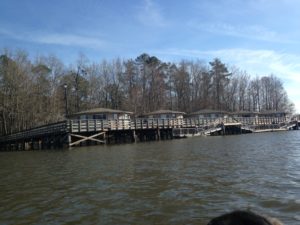 The campground has many cabins which look large and comfortable. Some are built right on the dock over the water – ideal for fishing.
The campground has many cabins which look large and comfortable. Some are built right on the dock over the water – ideal for fishing.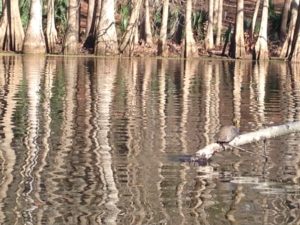 (Look on the branch coming out of the water.) Often we could see their comical heads lifted above the water as they swam. Oddly, there were also a lot of paper wasp nests hanging from the trees – mostly they seemed to be abandoned, but we did not take any chances.
(Look on the branch coming out of the water.) Often we could see their comical heads lifted above the water as they swam. Oddly, there were also a lot of paper wasp nests hanging from the trees – mostly they seemed to be abandoned, but we did not take any chances.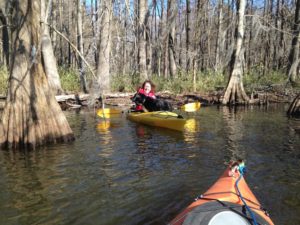 Luckily, even though at 14 1/2 he had never before been water over his ankles, his swimming instinct took over. (No picture of this – we were too busy making sure he did not drown.) Since we were unable to get him back into a kayak from the water, we guided him to shore. Then I had the unenviable task of getting him onto dry land, giving him a chance to roll around in the leaves to get some of the water and mud off, and then getting myself and a wet, muddy dog back in the kayak for the return trip. Luckily, no alligators or even wasps made an appearance (and the Lake Marion mud was less slippery than the Congaree mud). A very tired Rumple slept soundly that night.
Luckily, even though at 14 1/2 he had never before been water over his ankles, his swimming instinct took over. (No picture of this – we were too busy making sure he did not drown.) Since we were unable to get him back into a kayak from the water, we guided him to shore. Then I had the unenviable task of getting him onto dry land, giving him a chance to roll around in the leaves to get some of the water and mud off, and then getting myself and a wet, muddy dog back in the kayak for the return trip. Luckily, no alligators or even wasps made an appearance (and the Lake Marion mud was less slippery than the Congaree mud). A very tired Rumple slept soundly that night.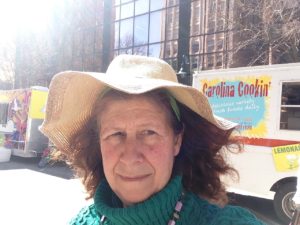
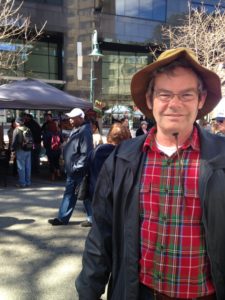
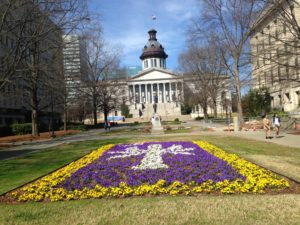 We had an excellent food truck lunch and then strolled to the end of the street where we walked around the grounds of the State Legislature – an impressive building. Tours are offered, but we decided that the hassle of parking Rumple was not worth it.
We had an excellent food truck lunch and then strolled to the end of the street where we walked around the grounds of the State Legislature – an impressive building. Tours are offered, but we decided that the hassle of parking Rumple was not worth it. 